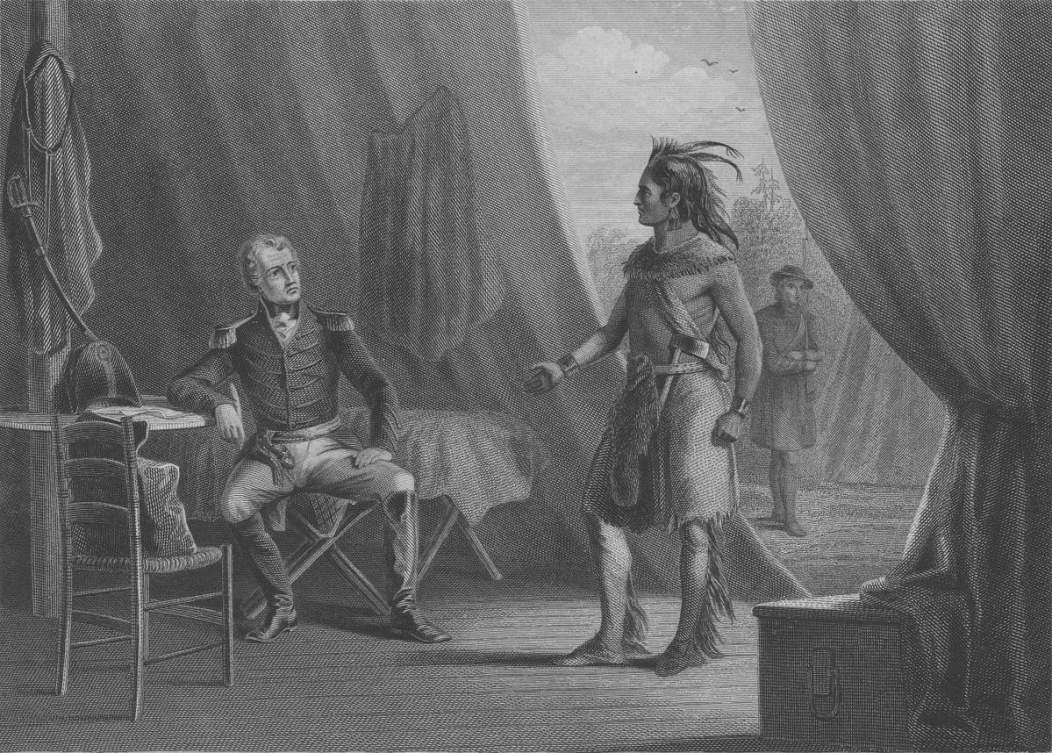The Creek Wars – In the early 18th century, SHAWNEE Tecumseh traveled south to look for allies for his rebellion against the United States. Once more many Creek leaders hedged. But during the years right away following Tecumseh’s Rebellion of 1809–11, many Creeks joined forces in their own uprising, which became recognized as the Creek War of 1813–14.
The Red Sticks (as whites called the militants after the tall red poles erected as declarations of war, or as a means of time-keeping using sticks to record the number of days of a war expedition), wanted war with the whites; the White Stick faction, as they became recognized, wanted peace.
Hence, the two mixed-bloods, Peter McQueen and William Weatherford led the Red Sticks; Big Warrior, a full-blooded Creek, led the White Sticks. The first incident concerned another full-blooded Creek by the name of Little Warrior, who had led a band of Creek against the Americans in the War of 1812. On the trip back from Canada after the engagement, his men brutally killed a number of settlers along the Ohio River.
The White Stick faction arrested and executed him for his deeds. Soon afterward, Peter McQueen led a force of Red Sticks to Pensacola on the Gulf of Mexico, where the Spanish gave them guns. This group then raided a party of settlers on Burnt Corn Creek in July 1813. The most renowned incident of the Creek War occurred the following month. William Weatherford, also known as Red Eagle, led a force of about 1,000 Red Sticks against Fort Mims on the Alabama River.
Black slaves reported to the commanding officer of the garrison, Major Daniel Beasley that Indians were heading toward the fort in the high grass. So far Beasley failed to order the outer gates closed. The attack soon came, and Beasley himself was killed in the first onslaught. The settlers took cover behind the inner walls and held the Warriors at bay for more than a few hours. In the end, flame-tipped arrows enabled the attackers to break through the defenses.
Once inside Fort Mims, they killed nearly four hundred settlers. Therefore, only 36 whites escaped. But the Red Sticks freed the black slaves. Federal and state troops were mobilized to suppress the uprising. General Andrew Jackson, whom the Indians called “Sharp Knife,” was given the command. Davy Crockett was one of his soldiers. There were a lot more battles.
In November 1813, soldiers drew the Red Sticks into a trap at Tallasahatchee, and then relieved the White Stick village of Talladega, which was under attack by a party of Red Sticks. In December, Red Eagle managed to escape troops closing in on his hometown of Econochaca by leaping off a bluff into a river while mounted on his horse.
In the middle of January 1814, there were two indecisive battles at Emuckfaw and Enotachopco Creek. The concluding battle took place at Horseshoe Bend in March 1814. There, Jackson’s men moved into position around the Red Sticks’ barricades, removed their canoes, and attacked. Therefore, the fighting lasted all day until the Indians, with most of their warriors killed, retreated.
Red Eagle survived, however, since he had departed before the attack to look over other fortifications. Red Eagle surrendered several days later. He walked into Jackson’s camp and announced, “I am Bill Weatherford.” To punish the Creek, Jackson forced them to sign the Treaty of Horseshoe Bend, which took away more than 23 million acres of land—from both the militant Red Sticks and the peaceful White Sticks.
Read More – Six Aircraft Used by Great Britain during World War II
